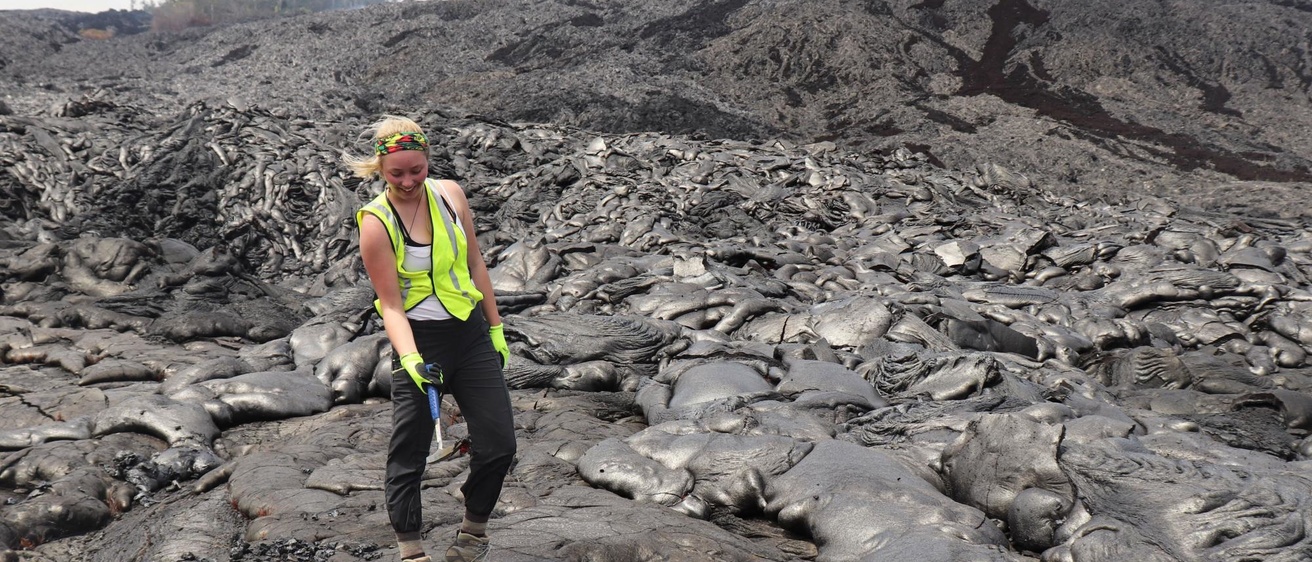University of Iowa geology students had a close brush with history—and a unique hands-on learning experience—that they likely never will forget.
Just two months before the Kilauea volcano in Hawaii began erupting on May 3—making news worldwide with an earthquake and lava flows that torched forests, engulfed roads and homes, and spewed toxic fumes—UI students visited the volcanic complex to learn about and study its features. Under the supervision of experienced UI faculty geologists, the students explored a region that was quiet at the time, yet hardly dormant, witnessing an active eruption and dipping their rock hammers into molten rock so hot it risked singing the hair on their arms.
“We were very close to where Kilauea erupted,” says Brittany Stolfus, a senior geosciences major from Freeport, Illinois. “You walk around and you look at past features, and you’re like, ‘That’s cool,’ and then eruptions are happening months later. It gives you an idea that this geological activity is ongoing and is actively forming volcanic features. It helps you understand it a lot more.”
Kilauea is a crater in Hawaii Volcanoes National Park, located on the island of Hawaii (also called the Big Island). It, along with park neighbor Mauna Loa, has been erupting regularly for decades, although most of the eruptions have been modest and posed little threat.

That changed in early May, when underground flows of molten rock, known as magma, ripped fiery fissures into the Earth along the east side of Hawaii Volcanoes National Park, like a series of stitches that suddenly burst open. Across the park, ash plumes erupted and lava flows snaked like red-hot rivers across the terrain. The see-saw flow of underground magma triggered a 6.9 magnitude earthquake on May 4 and, two weeks later, an ash plume that rose 30,000 feet above sea level.
The students and their faculty leader, Kate Tierney, in the UI Department of Earth and Environmental Sciences, traveled to Hawaii to explore geology alien to Iowa and the Midwest. The purpose, Tierney says, was at least two-fold: Introduce aspiring geologists to terrestrial processes they hadn’t seen before and add a real-life, in-place experience to complement what they have learned in the classroom.
“We want them to get their hands dirty, to hammer rocks and to pick them up,” says Tierney, who has organized and led dozens of student field trips to geologically diverse locales including Big Bend in Texas, as well as Montana, Missouri, and the Bahamas. “With these fields trips, you’re understanding what you learned and how it relates to the geological story.”
Allison Kusick recognized the difference as soon as she saw the nearly barren landscape as the plane approached the Big Island.
“Everything was black. Sparse vegetation,” recalls Kusick, a junior from West Branch, Iowa. “I had never seen that before. I was like, ‘OK, I’m not in Iowa anymore.’”
The group slept on a beach the first night, and after a morning dip in the ocean, journeyed into Hawaii Volcanoes National Park. So much of what they saw, touched, and examined was new and different—even exotic.
Kusick was especially smitten by a beach with greenish sand, colored by a mineral called olivine that precipitated out of rock from a collapsed volcano and then mixed with incoming ocean tides.
“You can take a handful right at the beach and it’s all green and you go into the water and pick it up, and it’s green, white, and black,” she says. “Then you go another 15 feet farther into the water, and there’s no green because the water has disassociated the ions and changed the form of the mineral.”

The group camped just a half-mile from Kilauea.
“It is active. Every night, the students walked to over to take a look,” Tierney says.
On another day, the students hiked six miles over hot, smoking lava fields that crunched beneath their boots. The goal: Reach a spot where the ground was torn, revealing lava, and “bless” their rock hammers by oh-so-gingerly dipping the ends in the molten rock.
“It was really uncomfortably hot,” Kusick recalls. “But then again, it’s lava.”
Elizabeth Flanagan, a senior from Bettendorf, Iowa, made her first trip as a communications studies major. She added a minor in geosciences after she returned.
“I felt a little out of place at first as a non-major, but I quickly realized how welcoming and supportive both my fellow students and professors were and have continued to be,” Flanagan says. “I plan to travel more with the department and would highly recommend that anyone and everyone with similar interests do the same.”
Volcanism occurs all over Earth and is one of the major processes, apart from the continued movement of continental land masses, by which the planet physically changes. What makes Hawaii special, Tierney says, is the opportunity to see those changes up close as they happen, “in one of the most monitored, controlled, and understood systems anywhere.”
Kusick calls it a “career-defining trip.”
“Earth is just so big and old and massive and there’s so much we have yet to learn,” she says. “I think that’s pretty remarkable. What better to devote your life to than understanding the place you live in, and the place that you owe your entire life to?”
